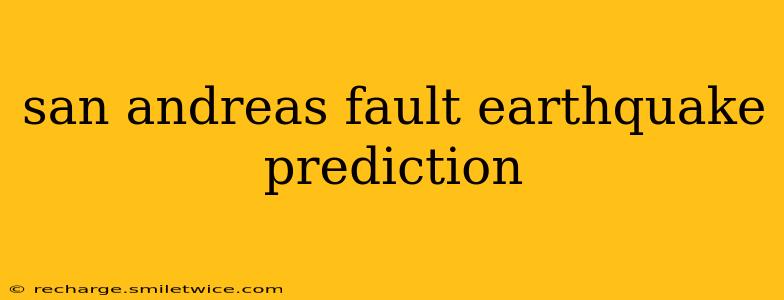The San Andreas Fault, a 800-mile-long continental transform fault zone, is one of the most studied and feared geological features on Earth. Its history of significant earthquakes, including the devastating 1906 San Francisco earthquake, fuels ongoing concerns about future seismic activity. While predicting the exact time, location, and magnitude of a San Andreas earthquake remains elusive, significant advancements in scientific understanding offer a more nuanced picture of earthquake potential. This article explores the complexities of San Andreas Fault earthquake prediction, addressing common questions and misconceptions.
Can We Predict Earthquakes on the San Andreas Fault?
Currently, no one can accurately predict when the next major earthquake will occur on the San Andreas Fault. While scientists cannot pinpoint the precise timing of a quake, they can assess the probability of future events based on various factors. This approach focuses on long-term forecasting rather than short-term prediction. Scientists employ a range of tools and techniques, continuously monitoring the fault's behavior for any precursory signs.
What are the Methods Used to Assess Earthquake Risk on the San Andreas Fault?
Several methods contribute to our understanding of earthquake potential on the San Andreas Fault:
-
Paleoseismology: This field studies past earthquakes by analyzing geological records, such as offset layers of sediment or soil. By examining the timing and magnitude of past earthquakes, scientists can estimate the recurrence intervals and potential magnitudes of future events.
-
Geodetic Measurements: GPS and other geodetic techniques precisely measure the movement of the Earth's crust along the fault. These measurements reveal the rate of accumulating strain, offering insights into the potential for future seismic release. Areas showing increased strain accumulation are considered to be at higher risk.
-
Seismic Monitoring: A dense network of seismometers continuously monitors ground motion along the San Andreas Fault. This data helps identify smaller earthquakes, which can provide clues about the stress build-up within the fault zone. Analyzing the frequency and location of these smaller events assists in risk assessment.
-
Stress Modeling: Sophisticated computer models analyze stress distribution along the fault, taking into account factors like plate tectonics and fault geometry. These models help identify segments of the fault that are under greater stress and therefore more prone to rupture.
How Often Do Major Earthquakes Occur on the San Andreas Fault?
The San Andreas Fault exhibits variable seismic behavior along its length. Some segments have a history of frequent, moderate-sized earthquakes, while others experience less frequent but potentially more devastating ruptures. The recurrence intervals for major earthquakes (magnitude 7.0 or greater) vary considerably, with estimates ranging from decades to centuries for specific sections of the fault.
What are the Signs of an Imminent Earthquake on the San Andreas Fault?
There are no reliable precursors that consistently predict imminent earthquakes. While some changes in groundwater levels, gas emissions, or animal behavior have been reported before some earthquakes, these are not consistent or predictable enough to serve as reliable warning signs. Scientific research continues to explore potential precursors, but none have proven effective for earthquake prediction.
What is the Difference Between Earthquake Prediction and Earthquake Forecasting?
Earthquake prediction implies the ability to pinpoint the exact time, location, and magnitude of a future earthquake. This capability currently does not exist. Earthquake forecasting, on the other hand, focuses on probabilistic assessments. Scientists estimate the likelihood of an earthquake occurring within a specific time frame and geographic area, based on available data and scientific understanding.
How Can I Prepare for a San Andreas Earthquake?
Preparation is key to mitigating the risks associated with a San Andreas earthquake. Individuals and communities should:
-
Develop an emergency plan: This plan should include communication strategies, evacuation routes, and supply storage.
-
Secure your home: Reinforce structures, secure heavy objects, and learn how to shut off utilities.
-
Assemble an emergency kit: Include essential supplies such as food, water, first-aid kit, and medications.
The San Andreas Fault poses a significant seismic hazard, and while precise earthquake prediction remains a challenge, ongoing research and monitoring enhance our understanding of its behavior. Focusing on preparedness and community resilience are crucial steps in minimizing the impact of future earthquakes along the San Andreas Fault.
